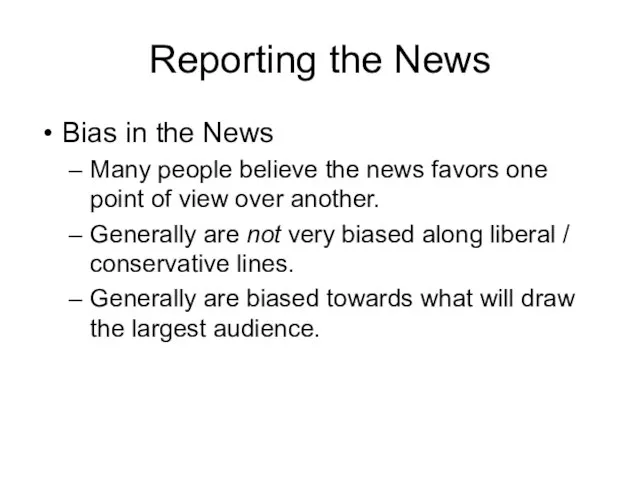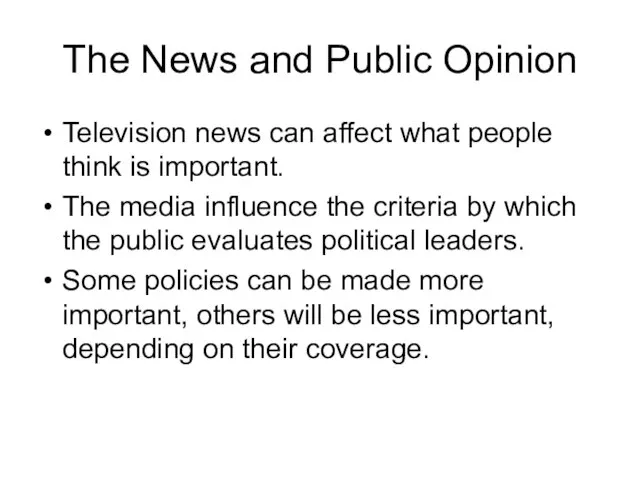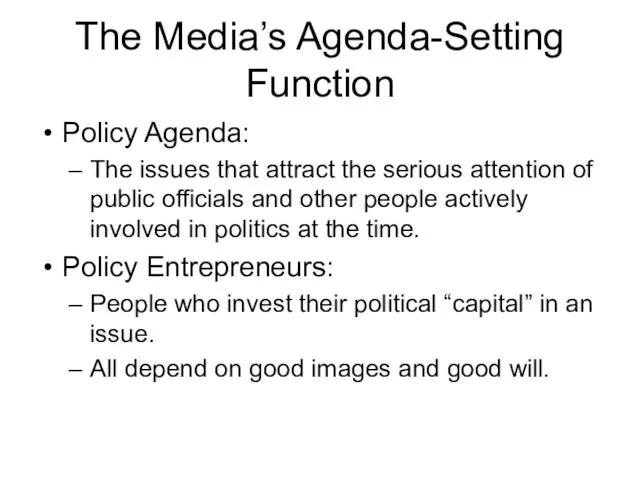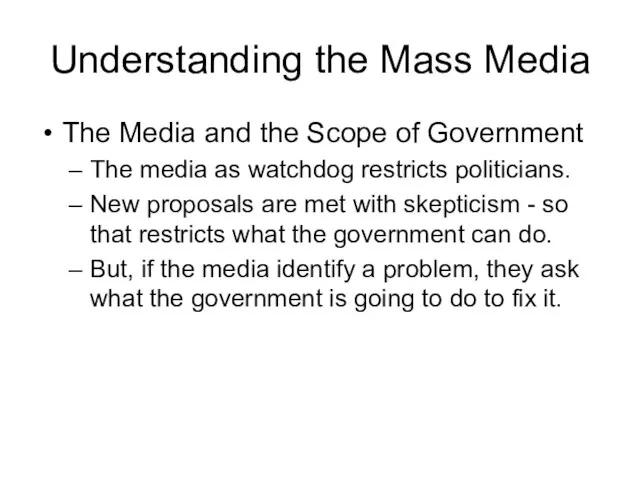Слайд 2Introduction
Mass Media:
Television, radio, newspapers, magazines, the Internet and other means of popular

communication.
High-tech politics:
A politics in which the behavior of citizens and policymakers and the political agenda itself are increasingly shaped by technology.
Слайд 3The Mass Media Today
Media Events:
Events purposely staged for the media that nonetheless

look spontaneous. Media events can be staged by almost anybody.
Other items to consider:
60% presidential campaign spending is TV ads
Image making / news management is important, especially for presidents
Слайд 4The Development of Media Politics
Introduction
The news media wasn’t always so important.
Press Conferences:

meetings of public officials with reporters - Roosevelt used many of these.
Investigative Journalism: the use of in-depth reporting to unearth scandals, scams & schemes putting reporters & politicians opposite each other.
Слайд 5The Development of Media Politics
The Print Media
Newspapers and magazines
“Yellow journalism” characterized newspapers

at the turn of the century.
Among the press there is a pecking order.
Newspaper circulation has been declining.
Magazines are also struggling.
Слайд 6Figure 7.1
The Development of Media Politics

Слайд 7The Development of Media Politics
The Broadcast Media
Television and radio
Brought government and politics

into people’s homes.
Made the politicians more aware of their appearance and mannerisms.
Television is the principal source of news for most Americans, and most believable.
Слайд 8The Development of Media Politics
Government Regulation of the Broadcast Media
The Federal Communications

Commission (FCC) regulates the use of airwaves.
Narrowcasting: Cable TV and the Internet
Media programming on cable TV or the Internet that is focused on one topic and aimed at a particular audience
Слайд 9The Development of Media Politics
Private Control of the Media
Only a small number

of TV stations are publicly owned in America.
The media are totally dependent on advertising revenues.
Chains consist of massive media conglomerates that control almost three-quarters of the nation’s daily newspaper circulation as well as broadcast media.
Слайд 10Reporting the News
Finding the News
Beats: Specific locations from which news frequently emanates,

such as Congress or the White House.
Trial Balloons: An intentional news leak for the purpose of assessing the political reaction.
Reporters and their sources depend on each other - one for stories, the other to get them out
Слайд 12Figure 7.2
Reporting the News
Presenting the News
Superficial describes most news coverage today
Sound Bites:

Short video clips of approximately 15 seconds.
Слайд 13Reporting the News
Bias in the News
Many people believe the news favors one

point of view over another.
Generally are not very biased along liberal / conservative lines.
Generally are biased towards what will draw the largest audience.
Слайд 14The News and Public Opinion
Television news can affect what people think is

important.
The media influence the criteria by which the public evaluates political leaders.
Some policies can be made more important, others will be less important, depending on their coverage.
Слайд 15The Media’s Agenda-Setting Function
Policy Agenda:
The issues that attract the serious attention of

public officials and other people actively involved in politics at the time.
Policy Entrepreneurs:
People who invest their political “capital” in an issue.
All depend on good images and good will.
Слайд 16Understanding the Mass Media
The Media and the Scope of Government
The media as

watchdog restricts politicians.
New proposals are met with skepticism - so that restricts what the government can do.
But, if the media identify a problem, they ask what the government is going to do to fix it.















 Инклюзивное обучение
Инклюзивное обучение представляет инновационный продукт Впервые в 21 веке
представляет инновационный продукт Впервые в 21 веке Индия. Китай. Япония
Индия. Китай. Япония Презентация на тему Круговорот кислорода в природе
Презентация на тему Круговорот кислорода в природе  Значение слова в контексте проблемы функциональной межполушарной асимметрии
Значение слова в контексте проблемы функциональной межполушарной асимметрии Клонирование человека: за и против
Клонирование человека: за и против Примерный перечень изделий для творческих проектов
Примерный перечень изделий для творческих проектов РАСТЕНИЯ НАШЕГО КРАЯ
РАСТЕНИЯ НАШЕГО КРАЯ Молодежная музыкальная Культура
Молодежная музыкальная Культура Презентация на тему Что такое биоинформатика?
Презентация на тему Что такое биоинформатика?  Развитие силы и силовой выносливости у младших школьников
Развитие силы и силовой выносливости у младших школьников Успехи и достижения учащихся 2А класса
Успехи и достижения учащихся 2А класса Презентация на тему Перпендикуляр и наклонная
Презентация на тему Перпендикуляр и наклонная  Кто я?
Кто я? Умеет ли компьютер думать?
Умеет ли компьютер думать? Разработка средств автоматическогосинтаксического анализа как модуля системы понимания текста
Разработка средств автоматическогосинтаксического анализа как модуля системы понимания текста ОСНОВЫ РЕЛИГИОЗНЫХ КУЛЬТУР И СВЕТСКОЙ ЭТИКИ
ОСНОВЫ РЕЛИГИОЗНЫХ КУЛЬТУР И СВЕТСКОЙ ЭТИКИ Канцерогенез и онкорезистентность
Канцерогенез и онкорезистентность Порядок выдвижения кандидатов в депутаты и представления документов для их регистрации
Порядок выдвижения кандидатов в депутаты и представления документов для их регистрации Динамика изменения микрофлоры при выработке и хранении колбасных изделий на ОАО Пинский мясокомбинат
Динамика изменения микрофлоры при выработке и хранении колбасных изделий на ОАО Пинский мясокомбинат Использование прикладных умений и навыков в профессиональной деятельности
Использование прикладных умений и навыков в профессиональной деятельности Управление экспертной деятельностью. Prof IT
Управление экспертной деятельностью. Prof IT Операции центрального банка на открытом рынке
Операции центрального банка на открытом рынке mon_cours_nouveau-ne_volet__2_copie_etud
mon_cours_nouveau-ne_volet__2_copie_etud Управление внутренней мотивацией работников при соблюдении требований охраны труда
Управление внутренней мотивацией работников при соблюдении требований охраны труда БРЯНЩИНА В ГОДЫ ВЕЛИКОЙ ОТЕЧЕСТВЕННОЙ ВОЙНЫ.
БРЯНЩИНА В ГОДЫ ВЕЛИКОЙ ОТЕЧЕСТВЕННОЙ ВОЙНЫ. Презентация на тему Буквенная запись свойств сложения и вычитания (5 класс)
Презентация на тему Буквенная запись свойств сложения и вычитания (5 класс) Возникновение и оценка техногенных месторождений
Возникновение и оценка техногенных месторождений